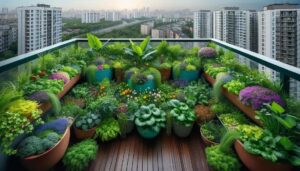Rooftop containers optimize urban space by offering durable, wind-resistant structures ideal for offices, gardens, and community spaces, with key considerations in material choice and installation ensuring stability and long-term usability.
Mobile containers on rooftops are changing the game in urban design. These wind-resistant solutions promise versatility and efficiency. Ever wondered how they withstand harsh conditions? Dive in to understand their applications and design.
how mobile rooftop containers work
Mobile rooftop containers offer a versatile solution for urban spaces, transforming underutilized rooftops into functional areas. These containers are specially designed for easy maneuverability, allowing them to be placed efficiently in high places. One key feature is their modular composition, which enables them to be customized and scaled according to the specific needs of the location. Constructed with lightweight yet durable materials, these containers can withstand environmental stresses while providing structural integrity.
Key Features of Mobile Rooftop Containers
Understanding how these containers function begins with their design. They often include adjustable bases that help in stabilizing on uneven surfaces. Additionally, their portability means they can be repurposed or relocated to align with changing urban layouts. The use of advanced insulation and ventilation systems ensures a comfortable internal environment, reflecting modern engineering principles aimed at sustainability.
Such containers empower city dwellers by offering solutions for communal, recreational, or commercial purposes without requiring permanent structures. Their flexibility and efficiency make them an attractive choice for urban planners looking to maximize space utilization on rooftops.
benefits of wind-resistant rooftop containers
Wind-resistant rooftop containers provide a robust solution for urban environments where strong winds are common. Their design focuses on stability, ensuring they remain secure and functional under extreme weather conditions. These containers are built with materials that not only resist wind pressure but also protect the contents inside from harsh elements.
One of the most significant advantages is their ability to maximize space efficiently by utilizing otherwise unused rooftop areas. This assists in urban planning by creating additional space for offices, gardens, or shared community spaces without the need for new construction.
Environmental and Economic Benefits
Deploying wind-resistant rooftop containers can also contribute positively to the environment by promoting green spaces. These containers can support vegetation that improves air quality and reduces urban heat. Economically, they offer a cost-effective alternative to building permanent structures, enabling businesses and individuals to invest in sustainable infrastructure without extensive budgets.
The versatility and resilience they offer make them an ideal choice for cities aiming to integrate more sustainable and adaptive architectural solutions.
applications in urban environments
Rooftop containers offer a multitude of applications in urban environments, making efficient use of scarce space. These containers can house small offices or serve as creative studios, providing flexible workspaces above ground-level congestion. Additionally, they are ideal for urban agriculture, allowing communities to grow fresh produce without the need for expansive plots of land.
Pop-up shops and cafes also find a home on rooftops, adding vitality to the urban landscape. These temporary installations can draw foot traffic and provide unique consumer experiences. Eco-friendly solutions are further supported by utilizing containers for green roofs, which help reduce heat and improve air quality in city spaces.
Community and Recreational Uses
Transforming rooftops into community hubs is another innovative application. Spaces can be adapted for social gatherings, exercise classes, or art exhibits, making them true urban oases. By opening up rooftops to such activities, cities can enhance community engagement and promote cultural development while maximizing urban space.
design considerations for rooftop solutions
When designing rooftop solutions, several important factors must be considered to ensure safety and functionality. Structural integrity is paramount to withstand both the weight of the container and environmental stresses such as wind and rain. The choice of materials is critical; using lightweight but durable substances helps maintain stability while enhancing weather resistance.
Urban planners often consider accessibility and ease of installation. Rooftops should be accessible to allow safe transport of containers and facilitate maintenance. Incorporating design elements like ramps or cranes can greatly improve access and efficiency.
Aesthetic and Environmental Impact
Another consideration is the visual appeal and how it fits into the city’s skyline. Rooftop solutions should complement the existing architecture and contribute positively to the urban landscape. Incorporating green design principles, such as adding plants or using sustainable materials, not only enhances the aesthetic but also improves environmental performance by promoting biodiversity and energy efficiency.
choosing the right materials for durability
Selecting the appropriate materials is crucial to ensuring the longevity and resilience of rooftop containers. Lightweight metals like aluminum offer excellent durability and resistance to corrosion, making them a popular choice for structures exposed to the elements. They are not only strong but also reduce the overall weight, which is important for rooftop installations.
High-density polyethylene (HDPE) is another material frequently used due to its weather-resistant properties and ability to withstand UV rays without degrading. This makes it ideal for maintaining the structural integrity of containers over time.
Balancing Cost and Performance
It’s essential to balance cost considerations with material performance. While some materials may represent a higher investment, their long-term benefits often justify the initial expense through reduced maintenance and increased lifespan. Additionally, incorporating recycled materials can enhance sustainability without compromising on durability. Each project demands an assessment of specific needs, ensuring materials align with both environmental conditions and budget constraints.
installation tips for optimal performance
Proper installation of rooftop containers is crucial to ensuring their performance and longevity. One essential tip is to conduct a thorough site assessment before installation. This includes checking the structural capacity of the roof and ensuring that it can support the weight of the containers.
Use appropriate anchoring systems to secure the containers against wind and other environmental forces. It’s also important to consider drainage solutions to prevent water accumulation, which could lead to structural damage over time.
Ensuring Easy Maintenance
To facilitate easy maintenance, ensure that there is ample access to all sides of the container. Choose locations and installation methods that allow for straightforward maintenance and inspections. Integrating technology like sensors can help monitor conditions within and around the containers, alerting to potential issues before they become serious problems.
Finally, consider collaborating with professionals who specialize in rooftop installations. Their experience can guide you through potential challenges and ensure a smoother installation process.
Unlock the Potential of Rooftop Solutions
Mobile rooftop containers offer innovative solutions for urban spaces, utilizing otherwise overlooked areas effectively. From wind-resistant designs to versatile applications, these structures provide environmental and economic benefits.
Designing these rooftop solutions with the right materials ensures durability, while careful installation supports optimal performance and longevity. Balancing aesthetics and functionality helps integrate these containers seamlessly into urban landscapes.
Considering community, commercial, and recreational uses, rooftop containers can transform city living. By choosing the right design and materials, and following best installation practices, you can maximize space and create vibrant urban environments.
FAQ – Common Questions About Rooftop Container Solutions
What are the main benefits of using rooftop containers?
Rooftop containers maximize space, enhance urban aesthetics, and are eco-friendly solutions that provide additional room for various uses, like offices and gardens.
How do wind-resistant designs improve rooftop containers?
Wind-resistant designs ensure containers remain stable during harsh weather conditions, protecting the contents and extending the container’s lifespan.
What materials are best for rooftop containers?
Lightweight yet durable materials like aluminum and high-density polyethylene offer excellent durability and weather resistance for rooftop containers.
How can rooftop solutions support urban agriculture?
Rooftop containers can be utilized for urban agriculture by converting underused spaces into productive gardens, supporting local food production.
What should be considered during the installation of rooftop containers?
Consider the structural capacity of the roof, use proper anchoring systems, ensure adequate drainage, and maintain easy access for inspections.
Can rooftop containers be used for community events?
Yes, rooftop containers can be reconfigured to host community events, providing unique venues for gatherings and enhancing social interaction.



